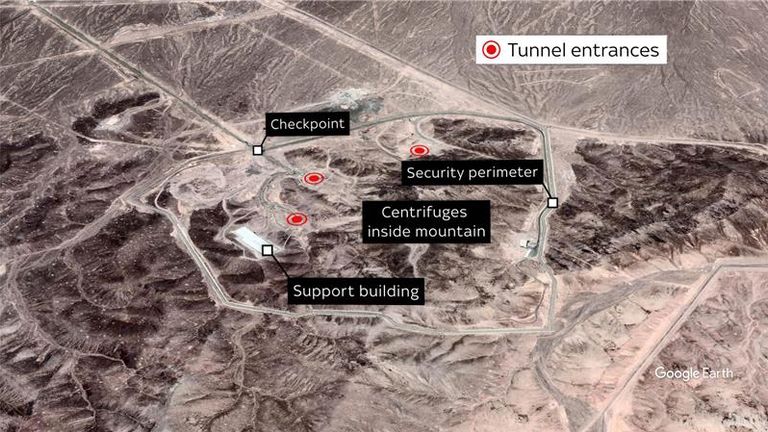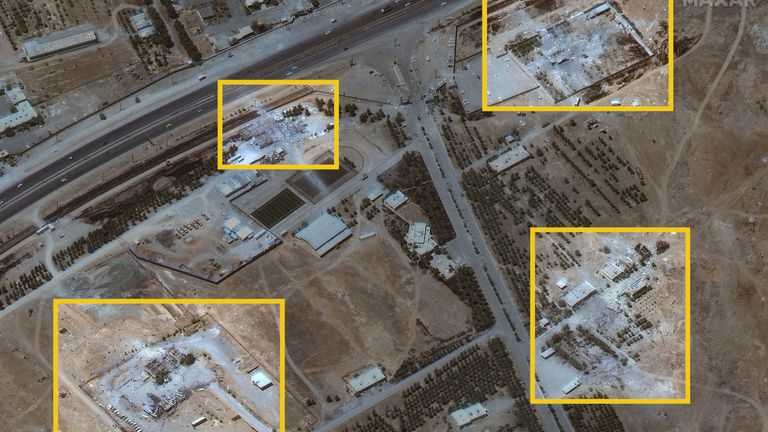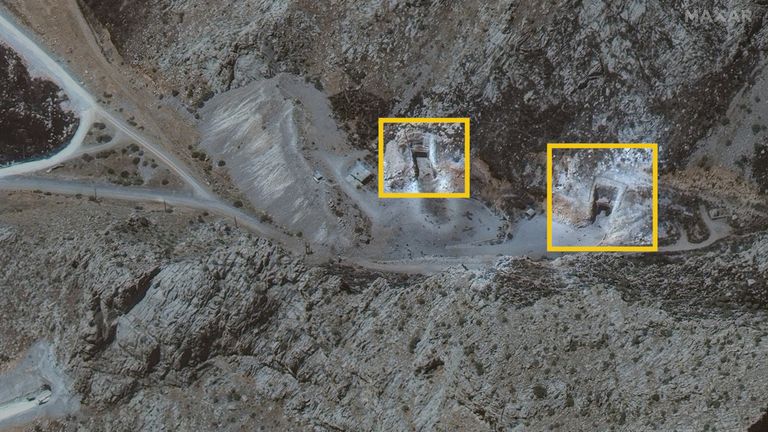Flight tracking data shows extensive movement of US military aircraft towards the Middle East in recent days, including via the UK.
Fifty-two US military planes were spotted flying over the eastern Mediterranean towards the Middle East between Monday and Thursday.
That includes at least 25 that passed through Chania airport, on the Greek island of Crete – an eight-fold increase in the rate of arrivals compared to the first half of June.
The movement of military equipment comes as the US considers whether to assist Israel in its conflict with Iran.
Of the 52 planes spotted over the eastern Mediterranean, 32 are used for transporting troops or cargo, 18 are used for mid-air refuelling and two are reconnaissance planes.
Forbes McKenzie, founder of McKenzie Intelligence, says that this indicates “the build-up of warfighting capability, which was not [in the region] before”.
Sky’s data does not include fighter jets, which typically fly without publicly revealing their location.
An air traffic control recording from Wednesday suggests that F-22 Raptors are among the planes being sent across the Atlantic, while 12 F-35 fighter jets were photographed travelling from the UK to the Middle East on Wednesday.
Many US military planes are passing through UK
A growing number of US Air Force planes have been passing through the UK in recent days.
Analysis of flight tracking data at three key air bases in the UK shows 63 US military flights landing between 16 and 19 June – more than double the rate of arrivals earlier in June.
On Thursday, Sky News filmed three US military C-17A Globemaster III transport aircraft and a C-130 Hercules military cargo plane arriving at Glasgow’s Prestwick Airport.
Flight tracking data shows that one of the planes arrived from an air base in Jordan, having earlier travelled there from Germany.
What does Israel need from US?
Israeli Prime Minister Benjamin Netanyahu said on 15 March that his country’s aim is to remove “two existential threats – the nuclear threat and the ballistic missile threat”.
Israel says that Iran is attempting to develop a nuclear bomb, though Iran says its nuclear facilities are only for civilian energy purposes.
A US intelligence assessment in March concluded that Iran is not building a nuclear weapon. President Trump dismissed the assessment on Tuesday, saying: “I think they were very close to having one.”
Forbes McKenzie says the Americans have a “very similar inventory of weapons systems” to the Israelis, “but of course, they also have the much-talked-about GBU-57”.
The GBU-57 is a 30,000lb bomb – the largest non-nuclear bomb in existence. Mr McKenzie explains that it is “specifically designed to destroy targets which are very deep underground”.
Experts say it is the only weapon with any chance of destroying Iran’s main enrichment site, which is located underneath a mountain at Fordow.
Air-to-air refuelling could allow Israel to carry larger bombs
Among the dozens of US aircraft that Sky News tracked over the eastern Mediterranean in recent days, more than a third (18 planes) were designed for air-to-air refuelling.
“These are crucial because Israel is the best part of a thousand miles away from Iran,” says Sky News military analyst Sean Bell.
“Most military fighter jets would struggle to do those 2,000-mile round trips and have enough combat fuel.”
The ability to refuel mid-flight would also allow Israeli planes to carry heavier munitions, including bunker-buster bombs necessary to destroy the tunnels and silos where Iran stores many of its missiles.
Satellite imagery captured on 15 June shows the aftermath of Israeli strikes on a missile facility near the western city of Kermanshah, which destroyed at least 12 buildings at the site.
At least four tunnel entrances were also damaged in the strikes, two of which can be seen in the image below.
Writing for Jane’s Defence Weekly, military analyst Jeremy Binnie says it looked like the tunnels were “targeted using guided munitions coming in at angles, not destroyed from above using penetrator bombs, raising the possibility that the damage can be cleared, enabling any [missile launchers] trapped inside to deploy”.
“This might reflect the limited payloads that Israeli aircraft can carry to Iran,” he adds.
Penetrator bombs, also known as bunker-busters, are much heavier than other types of munitions and as a result require more fuel to transport.
Israel does not have the latest generation of refuelling aircraft, Mr Binnie says, meaning it is likely to struggle to deploy a significant number of penetrator bombs.
Israel has struck most of Iran’s western missile bases
Even without direct US assistance, the Israeli air force has managed to inflict significant damage on Iran’s missile launch capacity.
Sky News has confirmed Israeli strikes on at least five of Iran’s six known missile bases in the west of the country.
On Monday, the IDF said that its strategy of targeting western launch sites had forced Iran to rely on its bases in the centre of the country, such as Isfahan – around 1,500km (930 miles) from Israel.
Among Iran’s most advanced weapons are three types of solid-fuelled rockets fitted with highly manoeuvrable warheads: Fattah-1, Kheibar Shekan and Haj Qassam.
The use of solid fuel makes these missiles easy to transport and fast to launch, while their manoeuvrable warheads make them better at evading Israeli air defences. However, none of them are capable of striking Israel from such a distance.
Iran is known to possess five types of missile capable of travelling more than 1,500km, but only one of these uses solid fuel – the Sijjil-1.
On 18 June, Iran claimed to have used this missile against Israel for the first time.
Iran’s missiles have caused significant damage
Iran’s missile attacks have killed at least 24 people in Israel and wounded hundreds, according to the Israeli foreign ministry.
The number of air raid alerts in Israel has topped 1,000 every day since the start of hostilities, reaching a peak of 3,024 on 15 June.
Iran has managed to strike some government buildings, including one in the city of Haifa on Friday.
And on 13 June, in Iran’s most notable targeting success so far, an Iranian missile impacted on or near the headquarters of Israel’s defence ministry in Tel Aviv.
Most of the Iranian strikes verified by Sky News, however, have hit civilian targets. These include residential buildings, a school and a university.
On Thursday, one missile hit the Soroka Medical Center in Beersheba, southern Israel’s main hospital. More than 70 people were injured, according to Israel’s health ministry.
Iranian foreign minister Abbas Araghchi said that Iran had struck a nearby technology park containing an IDF cyber defence training centre, and that the “blast wave caused superficial damage to a small section” of the hospital.
However, the technology park is in fact 1.2km away from where the missile struck.
Photos of the hospital show evidence of a direct hit, with a large section of one building’s roof completely destroyed.
Iran successfully struck the technology park on Friday, though its missile fell in an open area, causing damage to a nearby residential building but no casualties.
Israel has killed much of Iran’s military leadership
It’s not clear exactly how many people Israel’s strikes in Iran have killed, or how many are civilians. Estimates by human rights groups of the total number of fatalities exceed 600.
What is clear is that among the military personnel killed are many key figures in the Iranian armed forces, including the military’s chief of staff, deputy head of intelligence and deputy head of operations.
Key figures in the powerful Revolutionary Guard have also been killed, including the militia’s commander-in-chief, its aerospace force commander and its air defences commander.
On Thursday, Israeli Prime Minister Benjamin Netanyahu said that US assistance was not necessary for Israel to win the war.
“We will achieve all our objectives and hit all of their nuclear facilities,” he said. “We have the capability to do that.”
Forbes McKenzie says that while Israel has secured significant victories in the war so far, “they only have so much fuel, they only have so many munitions”.
“The Americans have an ability to keep up the pace of operations that the Israelis have started, and they’re able to do it for an indefinite period of time.”
Additional reporting by data journalist Joely Santa Cruz and OSINT producers Freya Gibson, Lina-Sirine Zitout and Sam Doak.
The Data and Forensics team is a multi-skilled unit dedicated to providing transparent journalism from Sky News. We gather, analyse and visualise data to tell data-driven stories. We combine traditional reporting skills with advanced analysis of satellite images, social media and other open source information. Through multimedia storytelling we aim to better explain the world while also showing how our journalism is done.
Content Source: news.sky.com






